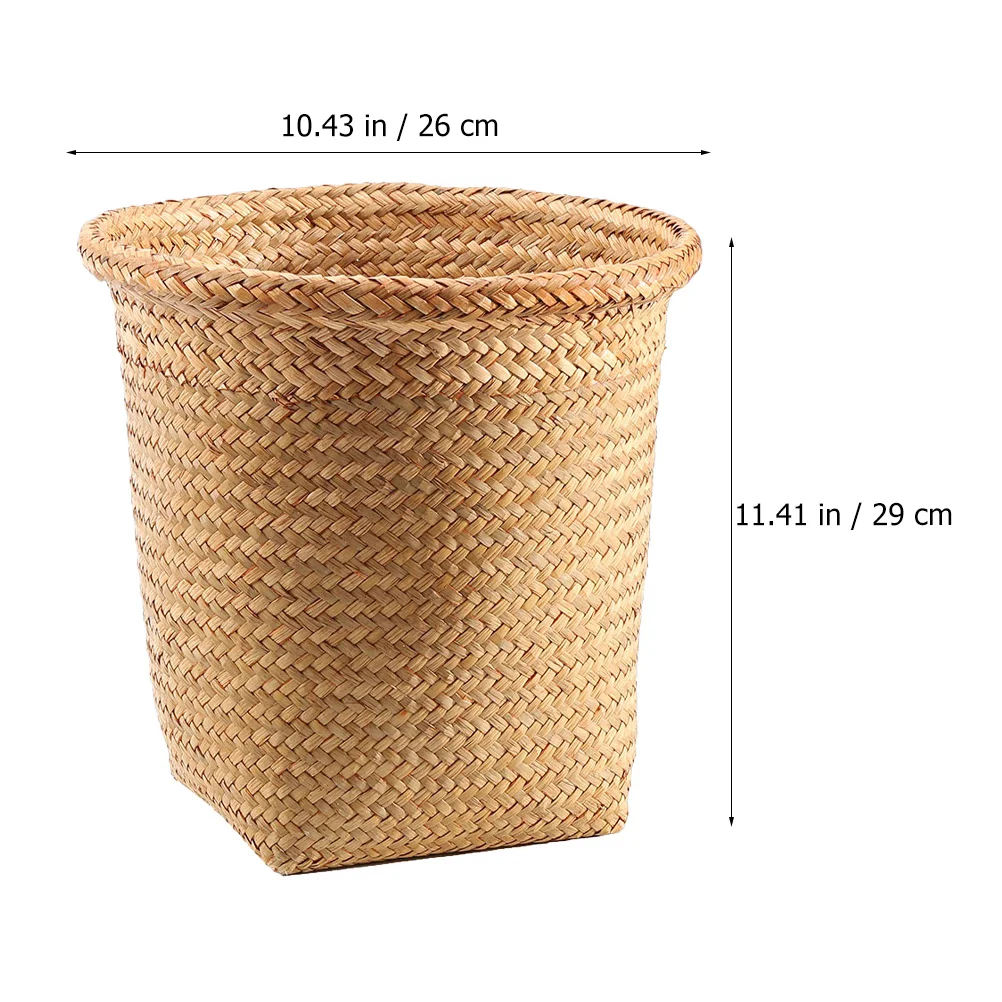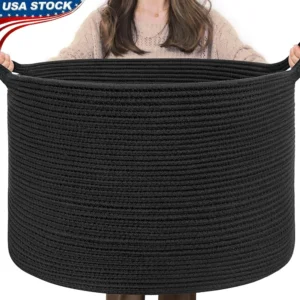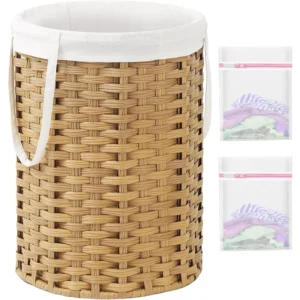1. Understanding the Difference Between Natural and Synthetic Wicker Laundry Baskets
When shopping for laundry baskets, you’ll likely encounter the term “wicker” frequently, but it’s important to understand that wicker isn’t actually a material—it’s a weaving technique. This distinction matters when choosing between natural and synthetic options for your home.
Natural wicker is crafted from plant-based materials that grow in nature, including:
– Rattan: A climbing palm with flexible, sturdy vines
– Bamboo: Fast-growing grass known for its strength and sustainability
– Seagrass: Durable marine plant with natural water resistance
– Willow: Pliable wood branches ideal for traditional basket weaving
On the other hand, synthetic wicker is manufactured using human-made materials such as:
– Resin: Plastic polymers molded to mimic natural wicker’s appearance
– HDPE (High-Density Polyethylene): Durable plastic with good weather resistance
– Polypropylene: Lightweight plastic that resists moisture damage
Choosing between natural vs synthetic wicker for your laundry basket involves understanding how each material will perform in your specific home environment. Each option offers distinct advantages in terms of durability, maintenance, and aesthetic appeal. The differences between these materials extend beyond mere appearance, affecting how your laundry basket will function and last over time.
As you consider which type of laundry basket best suits your needs, understanding the fundamental synthetic vs natural wicker guide will help you make an informed decision based on your lifestyle requirements and home décor preferences.
2. Natural Wicker Laundry Baskets: Materials, Characteristics, and Aesthetics
Natural wicker laundry baskets bring a touch of organic beauty and traditional craftsmanship to your home. Each natural material used in these baskets offers its own unique characteristics:
Rattan stands out as perhaps the most widely used natural wicker material, prized for its exceptional strength-to-weight ratio and flexibility. These qualities make it ideal for creating sturdy laundry baskets that can handle heavy loads without adding unnecessary weight.
Bamboo offers remarkable tensile strength—stronger than steel by weight—while remaining lightweight and flexible enough for intricate weaving patterns. Bamboo laundry baskets often feature tighter, more uniform weaves.
Seagrass brings natural water resistance and a distinctive textural quality. Its subtle variations in color create visual interest in laundry baskets, with colors ranging from pale green when new to golden brown as it ages.
Willow branches have been used in traditional basket weaving for centuries. Their exceptional pliability allows artisans to create both sturdy frameworks and delicate decorative elements in laundry baskets.
Reed, often harvested from wetland grasses, offers excellent flexibility and is frequently used in combination with sturdier materials to create visual contrast and texture variation.
The manufacturing of natural wicker baskets typically involves:
– Hand-harvesting of materials
– Natural drying and preparing processes
– Skilled hand-weaving techniques passed down through generations
– Finishing treatments that enhance durability while preserving natural appearance
What makes natural wicker laundry baskets truly special is their one-of-a-kind appearance. No two pieces are exactly alike due to:
– Natural variations in fiber color and thickness
– Unique growth patterns in each plant material
– Individual craftsman techniques and regional weaving styles
– Distinctive texture variations that create visual interest
These baskets complement a wide range of home décor styles, from rustic farmhouse to bohemian, coastal, and even traditional designs. The warm, earthy tones and organic textures of natural basket weaving materials create a sense of connection to nature that synthetic materials simply cannot replicate.
For those seeking authentic natural materials, our rattan laundry baskets collection showcases the beauty of traditionally crafted pieces that combine functionality with timeless appeal.
3. Synthetic Wicker Laundry Baskets: Materials, Technology, and Design
Synthetic wicker laundry baskets represent the marriage of modern technology with traditional basket-weaving aesthetics. These innovative products are crafted from several human-made materials:
Resin forms the foundation of many synthetic wicker products. This versatile material can be precisely engineered to create fibers with consistent strength and flexibility while remaining lightweight. Modern resin formulations allow manufacturers to achieve remarkably realistic wood-grain textures.
HDPE (High-Density Polyethylene) offers exceptional durability and UV resistance, making it particularly valuable for items that might be exposed to sunlight. This material resists cracking and fading even after years of use.
PVC (Polyvinyl Chloride) provides excellent moisture resistance and flexibility. It’s often used in lower-cost synthetic wicker products, though higher-quality versions have improved significantly in recent years.
Polypropylene creates lightweight yet sturdy wicker fibers that resist staining and are easy to clean. This material allows for the creation of incredibly fine, detailed weaving patterns.
The manufacturing process for synthetic wicker involves:
– Extrusion of plastic polymers into consistent, uniform fibers
– Computer-controlled weaving or molding techniques
– Heat treatments to ensure structural integrity
– Application of UV-resistant colorants throughout the material (not just surface coatings)
One of synthetic wicker’s greatest advantages is its design versatility. Manufacturers can create:
– Perfectly uniform weaving patterns impossible with natural materials
– Vibrant colors beyond what’s available in nature
– Specialized textures that mimic premium natural materials
– Innovative shapes and structures difficult to achieve with natural fibers
Modern synthetic wicker technology has advanced significantly, allowing these materials to closely mimic the look and feel of natural wicker while offering enhanced performance characteristics. Many people can’t distinguish high-quality synthetic wicker from natural materials without close inspection.
While some purists prefer natural materials, many homeowners appreciate knowing whether synthetic wicker is safe for laundry storage. Modern manufacturing standards have addressed many historical concerns about chemicals in synthetic materials, making today’s products significantly safer than previous generations.
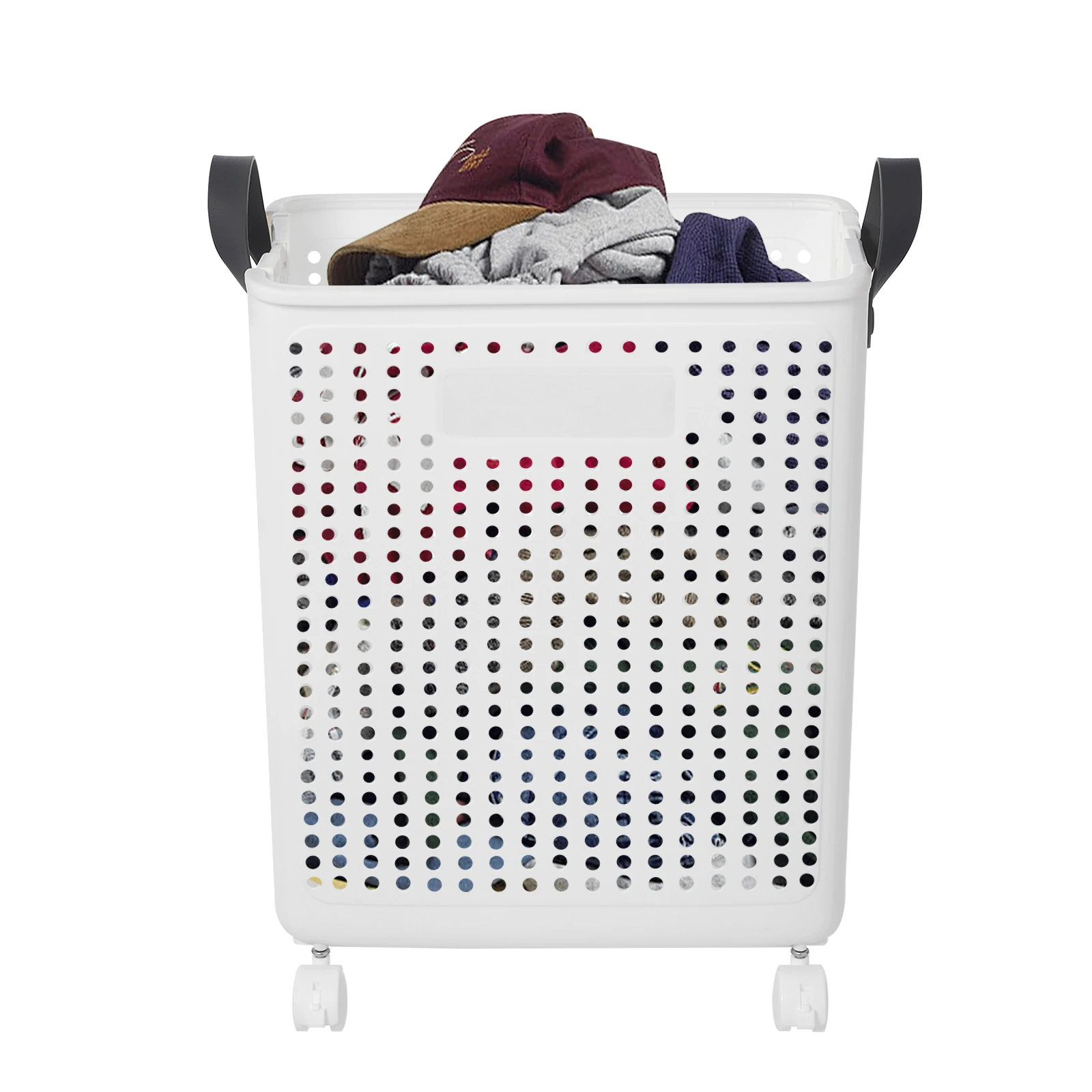
4. Comprehensive Comparison: Natural vs. Synthetic Wicker Laundry Baskets
To help you make an informed decision, let’s compare natural and synthetic wicker laundry baskets across key factors that impact your daily use and long-term satisfaction:
| Feature | Natural Wicker | Synthetic Wicker |
|---|---|---|
| Durability | 3-10 years depending on care | 5-15+ years with minimal maintenance |
| Moisture Resistance | Low to moderate; prone to mildew | Excellent; waterproof in most cases |
| Weight | Moderate to heavy | Light to moderate |
| Aesthetic Appeal | Warm, organic, unique variations | Clean, consistent, wide color range |
| Initial Cost | $50-200+ for quality pieces | $30-150 for comparable quality |
| Long-term Value | May require replacement sooner | Often outlasts natural alternatives |
| Maintenance | Regular dusting, occasional deep cleaning | Simple wipe-down cleaning |
| Environmental Impact | Biodegradable, renewable resources | Petroleum-based, not biodegradable |
| Breathability | Excellent; allows air circulation | Good in well-designed pieces |
| Health Considerations | Potential for dust/mold allergies | Possible off-gassing when new |
Natural wicker excels in creating a warm, organic aesthetic that brings natural elements into your home. Each piece tells a unique story through its variations in color and texture. However, this beauty comes with practical limitations—particularly sensitivity to moisture and potentially higher maintenance requirements.
Synthetic wicker shines in durability and practicality. It can withstand humid environments without developing mold or mildew, making it ideal for bathrooms and laundry rooms. Modern synthetic options also offer impressive aesthetic versatility, with some premium versions nearly indistinguishable from natural materials.
When choosing between synthetic and natural wicker, consider your specific home environment. Natural wicker may be perfectly suitable in dry, climate-controlled spaces where its beauty can be preserved. However, synthetic options generally perform better in challenging environments like bathrooms, basements, or humid climates.
The weight difference between these materials can also be significant. Natural wicker laundry baskets tend to be heavier, which provides stability but may be less convenient for those who need to move their laundry basket frequently. Synthetic alternatives offer lighter weight without sacrificing capacity.
For households with varying needs, our diverse collection of wicker laundry baskets includes both natural and synthetic options to suit any preference or practical requirement.
5. Durability and Longevity: What to Expect From Each Material
Understanding the durability factors for both natural and synthetic wicker helps you make a purchase that will stand the test of time.
Natural Wicker Durability Factors:
– Typically lasts 3-10 years with proper care
– Durability varies significantly by specific material (rattan being among the most durable)
– Common wear patterns include:
– Loosening of weave over time
– Potential splitting or breaking at stress points
– Color fading when exposed to direct sunlight
– Brittleness developing in very dry environments
– Climate impact is substantial—natural wicker lasts longer in moderate humidity (30-50%) and consistent temperatures
– Weight capacity depends on construction, but generally lower than synthetic alternatives
Synthetic Wicker Durability Advantages:
– Average lifespan of 5-15+ years, often with minimal maintenance
– Superior UV resistance prevents fading and brittleness from sun exposure
– Higher weight capacity due to engineered materials designed for strength
– Resistance to breaking and cracking, even under heavy loads
– Consistent performance across various environmental conditions
– Maintains structural integrity in temperature extremes that would damage natural fibers
In comparative durability testing, synthetic vs natural wicker materials show significant performance differences in challenging conditions. While both perform well in ideal environments, synthetic wicker maintains its integrity better when faced with:
- Repeated exposure to high humidity
- Frequent temperature fluctuations
- Heavy loads or constant use
- Cleaning with household chemicals
- Contact with wet clothing or damp items
Natural wicker typically shows wear patterns that develop character over time—slight darkening of the fibers and gentle softening of the weave. Some owners appreciate this patina as it gives the basket a lived-in, authentic quality.
Synthetic wicker tends to maintain its original appearance much longer, with minimal changes even after years of use. This consistency appeals to those who value a polished, maintained look throughout the product’s lifespan.
When considering investment value, the longer potential lifespan of synthetic wicker may offset its sometimes higher initial cost, especially in challenging environments where natural wicker might require more frequent replacement.
6. Maintenance Requirements: Caring for Your Laundry Basket
Proper maintenance significantly extends the life of your laundry basket, regardless of material. Here’s how to care for both natural and synthetic wicker options:
Natural Wicker Maintenance Guide:
Regular Cleaning:
– Dust weekly with a soft brush or vacuum with brush attachment
– Wipe with a slightly damp cloth monthly (not soaking wet)
– Allow to air dry completely after cleaningHandling Moisture Issues:
– Immediately dry with a towel if wet laundry creates dampness
– Use a fan to speed drying if basket becomes wet
– Never soak natural wicker during cleaningPreventing Mold and Mildew:
– Ensure good air circulation around the basket
– Keep away from direct sources of moisture
– Consider using a dehumidifier in very humid roomsAddressing Damage:
– Tuck in loose ends as they appear
– Apply boiled linseed oil sparingly to restore flexibility if drying out
– Support heavy loads from the bottom to prevent stress on handles
Synthetic Wicker Maintenance Guide:
Routine Cleaning:
– Wipe with damp cloth and mild soap as needed
– Rinse with clean water (can be more thorough than with natural wicker)
– Allow to air dry or towel dryStain Removal:
– Use diluted dish soap for most stains
– Apply baking soda paste for tougher marks
– Rinse thoroughly after cleaningPreventing Color Fading:
– Keep out of direct, intense sunlight if possible
– Rotate basket occasionally if one side receives more sun exposureMinor Repairs:
– Use clear nail polish to secure any loose ends
– Smooth rough edges with fine sandpaper if needed
The time investment difference is notable—natural wicker typically requires more frequent and careful maintenance to maintain its appearance and structural integrity. Synthetic wicker’s easy-care nature makes it particularly appealing for busy households or those who prefer low-maintenance home goods.
For added protection and easier maintenance, consider wicker laundry baskets with lids, which help keep dust out while providing a more finished appearance in your space.
7. Moisture Resistance: Performance in Humid Environments
The bathroom and laundry room present particularly challenging environments for wicker baskets due to their high humidity levels. Understanding how each material handles moisture is crucial for making a smart purchase decision.
Natural Wicker’s Response to Moisture:
Natural wicker materials have varying degrees of moisture sensitivity, but all are susceptible to damage from prolonged exposure:
- Rattan can absorb moisture, causing it to swell, warp, and potentially crack when it dries
- Seagrass offers slightly better natural moisture resistance but will still develop mold if consistently damp
- Bamboo may split or crack when exposed to repeated wet-dry cycles
- Willow becomes brittle when repeatedly exposed to moisture fluctuations
Signs of water damage in natural wicker include:
– White or gray mold spots developing on the surface
– A musty or mildewy smell
– Darkening of the fibers beyond normal patina
– Weakening of the structure, especially at joint points
Synthetic Wicker’s Moisture Advantages:
Synthetic wicker materials are specifically engineered to withstand moisture:
- Completely waterproof construction prevents water absorption
- Non-porous surfaces resist mold and mildew growth
- Maintains structural integrity even when regularly exposed to damp items
- Can be thoroughly washed without damage when needed
In bathroom environments, the performance difference becomes most apparent. Natural wicker baskets placed in bathrooms typically show signs of deterioration within months, while synthetic alternatives can maintain their appearance and structural integrity for years in the same conditions.
For laundry rooms where damp clothing is frequently present, synthetic wicker provides practical advantages in both durability and hygiene. The non-absorbent nature of synthetic materials prevents them from harboring moisture that could lead to unpleasant odors or mildew.
When considering whether wicker baskets are good for laundry storage, the answer largely depends on the specific material and your environment. In dry, well-ventilated spaces, both materials can perform well. However, in typical bathroom or laundry room conditions, synthetic wicker offers significantly better moisture resistance and longevity.
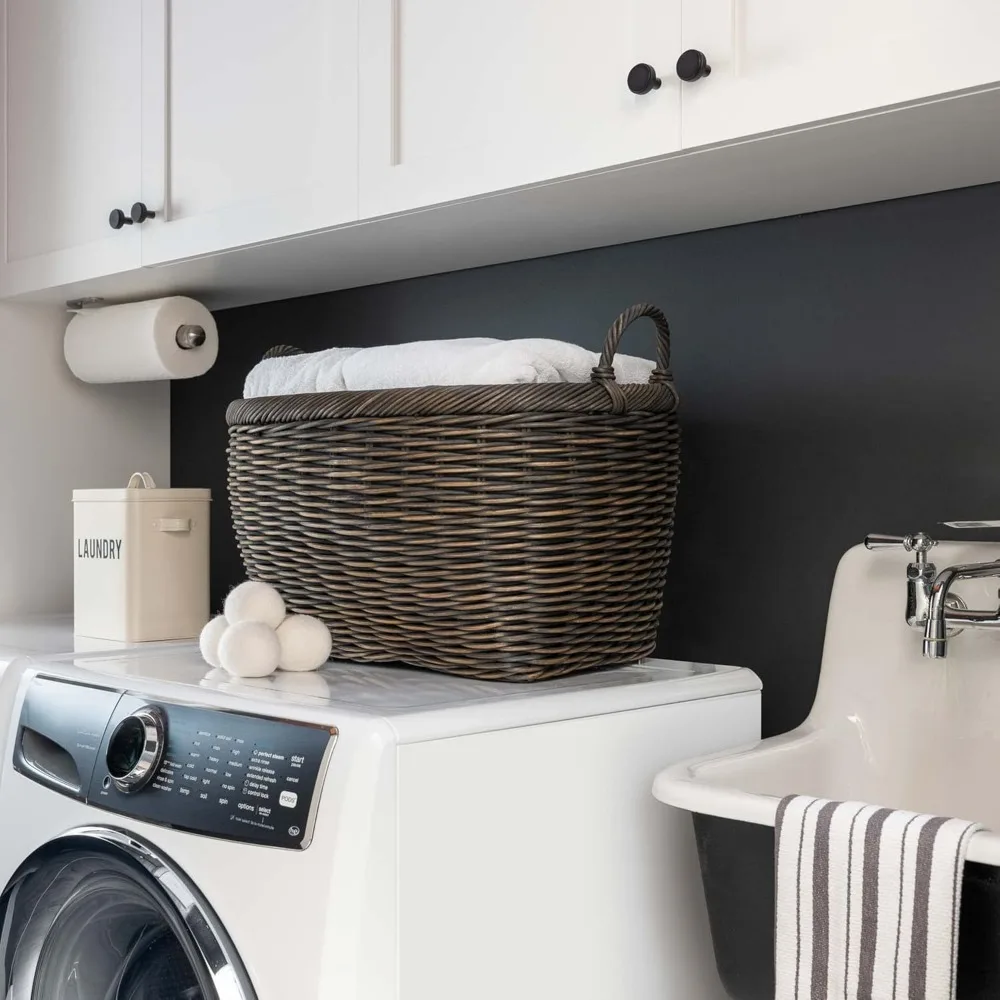
8. Environmental Considerations and Sustainability
The environmental impact of your laundry basket choice extends beyond its immediate use in your home. Both natural and synthetic wicker options present different environmental considerations worth understanding.
Natural Wicker Environmental Profile:
Natural wicker materials offer several ecological advantages:
– Renewable resource that can be regrown relatively quickly
– Biodegradable at end of life, returning to the soil
– Lower energy requirements in production compared to plastics
– Carbon sequestration during plant growth phase
However, sustainability concerns exist:
– Some harvesting practices can damage ecosystems if not properly managed
– Transportation impact can be significant if materials are sourced from distant locations
– Some treatments and finishes may contain non-eco-friendly chemicals
– Shorter lifespan may mean more frequent replacement and resource use
Synthetic Wicker Environmental Considerations:
Synthetic wicker presents a different environmental equation:
– Petroleum-based materials use non-renewable resources
– Manufacturing processes typically require more energy and produce more emissions
– Not biodegradable, potentially remaining in landfills for hundreds of years
– Some newer products can be recycled, though recycling infrastructure varies by location
Recent advancements in eco-friendly wicker basket materials have begun addressing these concerns. Some manufacturers now offer:
– Synthetic wicker made from recycled plastics
– Bio-based polymers derived partially from plant sources
– More energy-efficient production methods
– Take-back programs for proper disposal or recycling
For environmentally conscious consumers, the decision isn’t always straightforward. While natural materials may seem inherently more eco-friendly, their shorter lifespan in challenging environments means they may need more frequent replacement. Conversely, while synthetic materials last longer, their production and end-of-life impact present different environmental challenges.
The most sustainable choice often depends on your specific situation—including how you’ll use the basket, how long you expect to keep it, and what disposal or recycling options are available in your area when the product reaches its end of life.
9. Aesthetic Appeal and Home Décor Integration
The visual impact of your laundry basket plays a significant role in your overall satisfaction with the product, especially in homes where these items remain visible rather than hidden away.
Natural Wicker Aesthetic Qualities:
Natural wicker brings distinctive visual and tactile elements to your space:
– Warm, organic appearance with subtle color variations
– Natural imperfections that add character and uniqueness
– Textural richness that creates visual interest
– Earthy color palette ranging from pale blonde to rich amber and deep brown
These qualities make natural wicker particularly complementary to:
– Bohemian and eclectic décor styles
– Rustic, farmhouse, and country aesthetics
– Coastal and beach-inspired interiors
– Traditional and heritage design approaches
Synthetic Wicker Design Advantages:
Modern synthetic wicker offers impressive aesthetic versatility:
– Consistent coloration that can be precisely matched to your décor
– Wide color range beyond natural tones, including whites, blacks, and vibrant hues
– Uniform weaving patterns that create a more contemporary look
– Ability to mimic multiple natural materials in a single piece
Synthetic wicker tends to enhance:
– Modern and contemporary interiors
– Minimalist design approaches
– Color-coordinated spaces requiring exact shade matching
– Indoor-outdoor transitional spaces
The differences between wicker vs woven laundry baskets extend beyond materials to include specific aesthetic impacts. Wicker refers specifically to the weaving technique, while “woven” can encompass various construction methods—each creating distinct visual patterns and textures.
Beyond the material itself, design elements like basket shape, handle style, and finishing details significantly influence how well a laundry basket integrates with your home’s aesthetic. Some prefer the handcrafted, slightly irregular appearance of natural wicker for its authentic character, while others value the clean, consistent look of synthetic alternatives.
At Tidy Treasure, we believe your storage solutions should enhance your space visually while serving their practical purpose. The right laundry basket doesn’t just hold clothes—it contributes to the overall design story of your home.
Wicker Laundry Baskets, Woven Laundry Baskets, Woven Storage Baskets
$392.02 Select options This product has multiple variants. The options may be chosen on the product pageLarge Wicker Laundry Baskets, Tall Wicker Baskets, Woven Laundry Hampers, Woven Storage Baskets
$130.54 Select options This product has multiple variants. The options may be chosen on the product pageWoven Laundry Baskets, Woven Laundry Washing Baskets
Price range: $136.76 through $581.37 Select options This product has multiple variants. The options may be chosen on the product pageWicker Hampers with Lids, Wicker Laundry Baskets with Lids, Wicker Laundry Hampers
$127.33 Select options This product has multiple variants. The options may be chosen on the product pageWicker Blanket Baskets, Woven Laundry Baskets
$89.60 Select options This product has multiple variants. The options may be chosen on the product pageLarge Wicker Laundry Baskets, Rattan Laundry Baskets, Woven Laundry Hampers
$162.32 Select options This product has multiple variants. The options may be chosen on the product page
10. Best Use Cases: Matching the Laundry Basket to Your Needs
Finding the perfect match between your specific needs and the right laundry basket material ensures long-term satisfaction with your purchase. Consider these common scenarios:
For Humid Bathrooms and Laundry Rooms:
Synthetic wicker is the clear winner here. Its water-resistant properties prevent mold and mildew growth, even in steamy bathrooms. Natural wicker in these environments typically requires excessive maintenance and still risks deterioration over time.
For Homes with Children or Pets:
Synthetic wicker offers superior durability against rough handling. Children who might climb on or drop the basket, or pets who might chew on its edges, are less likely to damage synthetic materials. Additionally, synthetic wicker cleans more easily when faced with juice spills or pet accidents.
For Allergy-Sensitive Households:
Synthetic wicker provides advantages for allergy sufferers. Natural fibers can trap dust and potentially harbor mold spores if exposed to moisture. Synthetic alternatives are less likely to contribute to indoor allergens and can be thoroughly cleaned without deterioration.
For Heavy Laundry Loads:
High-quality synthetic wicker typically offers better weight capacity for households regularly handling large loads. The engineered materials maintain structural integrity even when fully loaded with wet towels or heavy jeans. Look for reinforced bottoms and handles in either material if you frequently carry heavy loads.
For Decorative Storage Purposes:
When the basket serves primarily as decorative storage in a dry, controlled environment, natural wicker often provides superior aesthetic appeal. Its organic texture and warm appearance create a more inviting visual impression in living areas or bedrooms.
For Multi-Purpose Use:
If you need a basket that might transition between rooms or functions, synthetic wicker offers more versatility. It adapts well to changing conditions and can serve multiple purposes without special care considerations.
For Outdoor Applications:
Only specially designed synthetic wicker should be considered for outdoor or semi-outdoor locations like covered porches. Natural wicker deteriorates rapidly when exposed to outdoor elements.
Understanding the ultimate guide to laundry basket materials helps you align your specific lifestyle needs with the right product characteristics. The best choice balances practical considerations like humidity levels and usage patterns with aesthetic preferences and budget constraints.
11. Cost Analysis: Initial Investment vs. Long-Term Value
Making a smart financial decision involves looking beyond the initial price tag to consider the total cost of ownership over time. Both natural and synthetic wicker laundry baskets present different value propositions:
Natural Wicker Pricing Factors:
Natural wicker laundry baskets typically range from $40 to $200+, with price variations based on:
– Material quality and rarity (premium rattan commanding higher prices)
– Craftsmanship complexity and hand-weaving time involved
– Size and capacity considerations
– Brand reputation and retail channel
The value equation for natural wicker includes:
– Potential replacement every 3-7 years in typical household conditions
– Higher maintenance costs in terms of time and specialized cleaning products
– Premium aesthetic appeal that may justify higher cost for visible placements
– Unique, artisanal qualities impossible to replicate in mass production
Synthetic Wicker Cost Considerations:
Synthetic wicker laundry baskets generally range from $30 to $150, with pricing influenced by:
– Quality of the polymer materials used (premium vs. basic)
– Manufacturing precision and weaving complexity
– Design innovation and brand positioning
– Included features like liners or specialized lids
The long-term value proposition includes:
– Typical lifespan of 5-15+ years under normal conditions
– Minimal maintenance costs over the product lifecycle
– Consistent appearance that maintains its value aesthetically
– Greater durability in challenging environments
For budget-conscious consumers, the initial price difference might make natural wicker seem more attractive. However, when calculating cost per year of use, synthetic options often prove more economical, especially in humid environments where natural materials deteriorate faster.
Quality indicators worth the investment in either material include:
– Tight, consistent weaving patterns
– Reinforced edges and stress points
– Smooth, finished surfaces without sharp edges
– Sturdy, well-attached handles
Our woven laundry baskets collection includes options at various price points, allowing you to select the best value based on your specific priorities and budget constraints.
12. Health and Safety Aspects: What You Should Know
Beyond practical and aesthetic considerations, health and safety factors should influence your choice between natural and synthetic wicker laundry baskets.
Natural Wicker Health Considerations:
Natural materials bring certain health aspects to consider:
– Potential allergens for sensitive individuals, particularly from dust that collects in the weave
– Natural fibers can release small particles as they age and break down
– Risk of mold and mildew development if exposed to moisture
– Possible splinters from aging or damaged pieces
– Some imported natural wicker may be treated with chemicals for pest prevention
To minimize these concerns:
– Regularly dust and clean natural wicker baskets
– Keep natural materials dry and well-ventilated
– Inspect for and sand down any developing rough spots
– Purchase from reputable sources that disclose treatment information
Synthetic Wicker Safety Aspects:
Synthetic materials present different health considerations:
– Potential for VOC (volatile organic compound) emissions in new products, though these typically diminish quickly
– Older or low-quality synthetic wicker may contain BPA or phthalates
– Higher-quality modern synthetic wicker is generally manufactured to strict safety standards
– Smoother surfaces less likely to cause skin irritation or snag delicate fabrics
To address these concerns:
– Allow new synthetic products to air out before using with clean laundry
– Choose products from reputable manufacturers that specify safety certifications
– Look for labels indicating “BPA-free” and “phthalate-free” materials
– Clean regularly to prevent dust accumulation
For households with young children, synthetic wicker often provides safety advantages through more consistent construction and smoother surfaces that resist splintering. For those with specific chemical sensitivities, high-quality natural wicker from trusted sources may be preferable.
Understanding how to identify natural vs synthetic rattan and other wicker materials helps ensure you’re making an informed choice about what materials are entering your home environment.
13. Practical Tips for Choosing the Right Laundry Basket
Making the final decision requires weighing multiple factors against your specific situation. Follow these steps to select the perfect laundry basket for your needs:
Assess Your Environment
Evaluate the humidity and temperature conditions where your basket will be used. Measure humidity levels if possible, especially in bathrooms and laundry areas. Synthetic wicker becomes increasingly advantageous as humidity levels rise above 60%.Calculate Your Capacity Needs
Consider your household size and laundry habits. Estimate the volume of laundry you typically handle and choose a size that accommodates your needs without becoming too heavy when full. Remember that natural wicker baskets tend to have weight limitations.Define Your Aesthetic Priorities
Decide how visible your laundry basket will be and how important its appearance is to your overall space. If it’s prominently displayed in a bedroom or bathroom, the aesthetic appeal might justify additional investment or maintenance requirements.Evaluate Your Maintenance Willingness
Be honest about how much time and effort you’re willing to devote to basket care. If you prefer low-maintenance solutions, synthetic options will better meet your needs.Establish Your Budget Framework
Determine both your initial budget and your willingness to potentially replace the basket sooner (with natural materials) versus investing more upfront for longer lifespan (with quality synthetic options).Consider Environmental Impact
Weigh the environmental considerations based on your personal values, including resource renewal, biodegradability, and product lifespan.
For a deeper dive into selection criteria, our complete wicker laundry basket guide provides additional insights on matching basket characteristics to specific household needs.
Remember that the “perfect” choice varies widely between households. A natural wicker basket might be ideal for a dry, climate-controlled bedroom in one home, while synthetic wicker would be absolutely necessary for a humid bathroom in another.
14. Premium Features to Look For in Quality Laundry Baskets
When investing in a higher-end laundry basket, certain premium features justify the additional cost through enhanced functionality and longevity:
Structural Enhancements Worth the Investment:
Reinforced Handles and Stress Points: Quality baskets feature additional weaving or support at handles and other high-stress areas that bear weight when the basket is lifted.
Double-Weaving Techniques: Premium baskets often utilize double-weaving methods where fibers cross multiple times, creating significantly stronger structures that resist stretching and deformation.
Removable Liners: High-end options may include washable fabric liners that protect both your laundry and the basket itself, extending the basket’s lifespan while adding convenience.
Specialized Treatments: Quality natural wicker may feature moisture-resistant treatments that don’t compromise appearance, while premium synthetic wicker often includes enhanced UV protection.
Ergonomic Design Elements: Thoughtfully contoured handles, balanced weight distribution, and appropriate height-to-width ratios make daily use more comfortable.
Smart Storage Features: Collapsible designs or nesting capabilities allow for space-saving storage when not in use—particularly valuable in smaller homes.
Ventilation Innovations: Strategic openings or mesh panels in the design promote airflow, reducing moisture buildup and odors from damp laundry.
Identifying quality craftsmanship requires attention to detail:
In natural wicker, look for:
– Consistent tension throughout the weave
– Smooth, finished ends with no sharp protrusions
– Tight joints where different pieces come together
– Natural oils or safe sealants that enhance longevity
In synthetic wicker, quality indicators include:
– Uniform coloration throughout the material (not just surface-dyed)
– Precision in the weaving pattern without gaps or irregularities
– UV-stabilized materials that resist fading and brittleness
– Smooth edges and corners that won’t snag fabrics
Our collection of premium wicker hampers with lids showcases these quality features, demonstrating how thoughtful design enhances both functionality and aesthetic appeal.
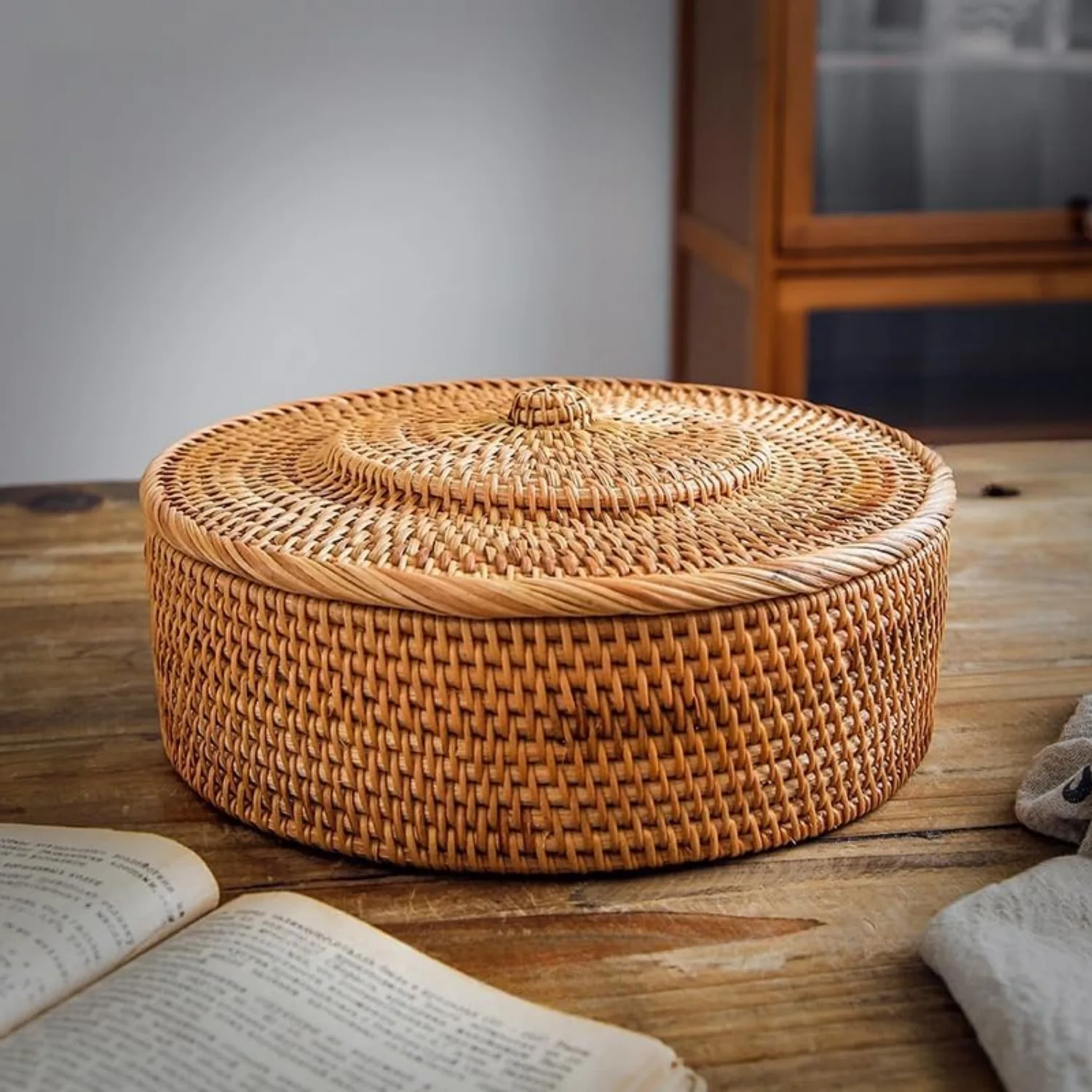
15. Beyond Wicker: Alternative Laundry Basket Materials to Consider
While wicker options dominate the laundry basket market, several alternative materials offer unique advantages worth considering:
Solid Plastic Options
Molded plastic laundry baskets provide unmatched durability and moisture resistance. Modern designs have evolved beyond utilitarian appearances, with sleek lines and attractive color options. These baskets excel in high-humidity environments and can be thoroughly sanitized when needed—making them ideal for households with infants or immunocompromised members.
Fabric and Canvas Alternatives
Collapsible fabric laundry hampers offer unparalleled storage flexibility when not in use. These lightweight options are excellent for small spaces or as secondary hampers in bedrooms. While they lack the structural rigidity of wicker, many feature reinforced sides and handles for improved stability. Look for removable, washable liners for the best hygiene maintenance.
Metal Wire Baskets
Industrial-chic wire baskets bring a modern aesthetic while providing excellent ventilation for damp items. These durable options often feature powder-coated finishes to prevent rusting. Their open design makes contents visible—both an advantage and disadvantage depending on your preference for concealment.
Solid Wood Designs
Wooden laundry chests offer sophisticated furniture-like appearances that blend seamlessly with bedroom décor. These premium options typically feature hinged lids and sometimes include dividers for sorting. While beautiful, they require similar maintenance considerations to natural wicker regarding humidity and moisture exposure.
Hybrid Material Combinations
Innovative designs increasingly combine materials for optimal performance—such as synthetic wicker baskets with metal frames for added strength, or natural wicker with waterproof liners to protect against moisture damage.
Each of these alternatives presents its own balance of practical performance, aesthetic appeal, and price considerations. For exploring options beyond traditional wicker, our laundry solutions collection features diverse material choices to suit various household needs and style preferences.
16. Is Natural or Synthetic Wicker Better for Your Laundry Needs?
After examining all aspects of both natural and synthetic wicker laundry baskets, the “better” choice clearly depends on your specific circumstances and priorities.
Natural wicker excels in creating warm, organic aesthetic appeal with unique character. Its craftsmanship and natural variations bring authenticity and texture to your space that manufactured materials simply cannot replicate. For environmentally conscious consumers, its renewable source materials and biodegradability offer important advantages.
Synthetic wicker shines in practical performance, particularly in challenging environments. Its superior moisture resistance, durability, and low maintenance requirements make it the logical choice for humid bathrooms, busy households, and situations where longevity is paramount. Modern manufacturing has significantly improved its appearance, with premium versions closely mimicking natural materials.
Your ideal choice depends on balancing several key factors:
– The humidity level where the basket will be used
– Your willingness to perform regular maintenance
– The importance of aesthetic appearance in your space
– Your budget considerations, both short and long-term
– Your environmental priorities and values
For most bathrooms and laundry rooms, synthetic wicker provides practical advantages that typically outweigh the aesthetic benefits of natural materials. However, in bedrooms and other dry, climate-controlled spaces, natural wicker can perform well while providing superior visual and tactile appeal.
Quality matters significantly regardless of material choice. A well-crafted basket in either material will outperform and outlast poorly made alternatives. When choosing between natural and synthetic wicker, prioritize craftsmanship indicators like tight weaving, reinforced stress points, and attention to detail in finishing.
Remember that the perfect laundry basket blends functionality with your personal style. Whether you choose the warm, organic appeal of natural wicker or the practical durability of synthetic alternatives, selecting a basket that complements your home while meeting your specific needs ensures long-term satisfaction with your choice.

